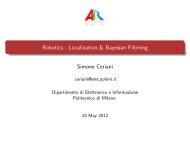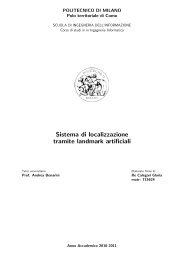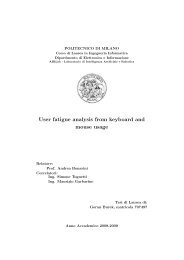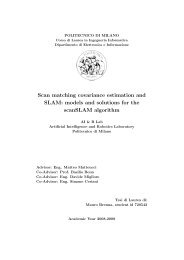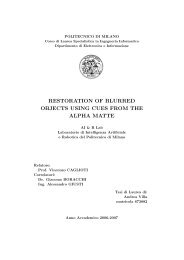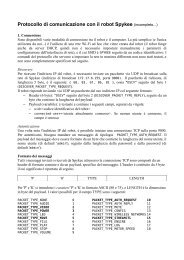Submitted version of the thesis - Airlab, the Artificial Intelligence ...
Submitted version of the thesis - Airlab, the Artificial Intelligence ...
Submitted version of the thesis - Airlab, the Artificial Intelligence ...
Create successful ePaper yourself
Turn your PDF publications into a flip-book with our unique Google optimized e-Paper software.
4.1. Wheel configuration 41<br />
Figure 4.1: The wheel position and robot orientation<br />
important to remember that <strong>the</strong> wheel driving direction is perpendicular to<br />
<strong>the</strong> motor axis (<strong>the</strong>refore 90 degrees more). The line <strong>of</strong> movement for each<br />
wheel (when driven by <strong>the</strong> motor and ignoring sliding forces) is represented<br />
in Figure 4.1 by solid, black arrows. The arrow indicates positive direction<br />
contribution. The total platform displacement is <strong>the</strong> sum <strong>of</strong> three vector<br />
components (one per motor) and is represented as a vector, applied to <strong>the</strong><br />
platform body center.<br />
In order to find out <strong>the</strong> three independent motor contributions, <strong>the</strong> composition<br />
<strong>of</strong> <strong>the</strong> vectors represented by red arrows is projected on axes representing<br />
<strong>the</strong> line <strong>of</strong> movement <strong>of</strong> each wheel.<br />
The calculation <strong>of</strong> <strong>the</strong> independent motor contributions is made using<br />
<strong>the</strong> following formulas:<br />
⎡ ⎤<br />
V t1<br />
⎢ ⎥<br />
⎣V<br />
t2⎦<br />
= MF ∗V<br />
V t3




